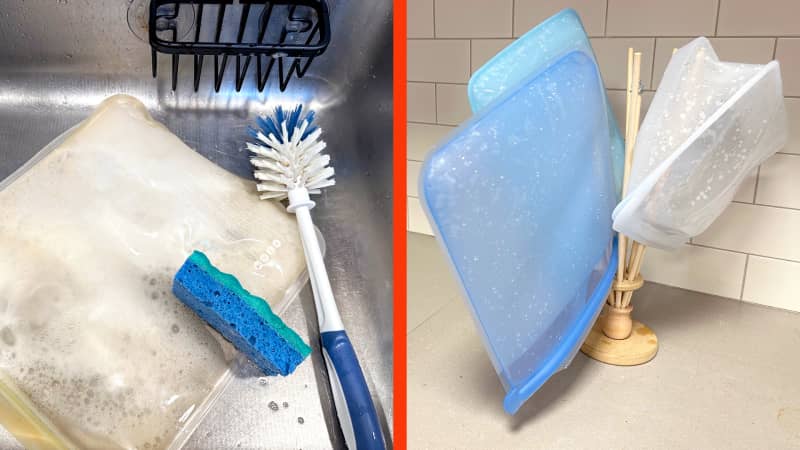First, good for you. You’ve taken the first step in reducing single-use plastics by buying a reusable food storage bag. Now you’ve eaten your bagged lunch, or used up those stored vegetables or frozen stew—and the bag needs washing.
What’s the Best Way to Clean (and Deodorize) a Reusable Food Storage Bag?
Published Jan. 26, 2024.

Our top-ranked reusable food storage bags have simpler shapes and seals that are easier to clean than many other reusables from other brands, but they still need to be washed after every use so they’re ready to re-use.
What’s the easiest, most effective way to do it? We tested several methods.
Sign up for the Well-Equipped Cook newsletter
Shop smarter with our ATK Reviews team's expert guides and recommendations.
How to Wash Reusable Bags
With these tips, you can keep your reusable bags in great working condition.
- Check to see if it’s dishwasher safe. If the manufacturer says it’s dishwasher-safe, your troubles may be over. Many brands of reusable bags can simply be propped open and run through the dishwasher—on the top or bottom rack, depending on the brand. Use a normal, not overly hot cycle for washing to keep bags in better shape long-term.
- When in doubt, hand-wash the bags. If your reusable bag isn’t dishwasher-safe, you’ll need to hand-wash it. Add a drop or two of dish soap, fill about halfway with hot tap water, seal the bag and slosh it around, then rinse well. If you need to get in there and scrub the inside, use the scrubby side of a kitchen sponge or a bottle brush, which is soft enough to not damage the bag. Be sure to fully clean and rinse the closure seal as well as the bottom corners of the bag (a bottle brush is best for this!).
- Never turn the bags inside out. No matter how you clean it, remember that most reusable bags shouldn’t be turned inside-out for washing and drying. This can rip the seams and damage the seal.
- Dry thoroughly. Be sure to dry the inside of your bag completely to prevent mold and bacterial growth. Never store a damp bag. You can wipe away most of the moisture with a dish towel, but then let it air dry fully. We recommend a bag drying rack; it keeps bags propped open for good air circulation and keeps them confined to a smaller area in your kitchen.
The Best Food Storage Bags
We want a strong, leakproof bag—reusable or not—that closes securely without a fuss and keeps food fresher for longer.How to Remove Stains from Reusable Bags
We put staining foods including tomato sauce and turmeric in reusable bags made of silicone or PEVA, and cleaned them a few days later, trying dish soap, a paste made of baking soda and water, and even Dawn Powerwash spray. We learned that stains can be persistent and may never fully come out, though they lighten gradually as you wash and use the bag a few more times.
While manufacturers recommend laying bags in the sun to remove stains, our tests showed it was only moderately effective, and to be honest, it felt a little silly to arrange storage-bag sunbathing. Your best bet? Choose bags with a color or pattern that hides mild staining and learn to live with it.
Kitchen Gear: The Ultimate Owner's Manual
Packed with science-backed advice from professional equipment reviewers, practical how-to guides, engrossing trivia, and 100+ recipes that showcase great gear, this guide is an indispensable source of collected wisdom found nowhere else.How to Erase Odors from Reusable Bags
You definitely don’t want your bag to smell like yesterday’s leftovers. In our tests, we put fragrant foods including minced garlic, cumin, fish sauce, and canned mackerel in bags and cleaned them a few days later.
To remove scents that persist after normal washing and drying, you can soak bags for a few hours or overnight in equal parts white distilled vinegar and warm water, then wash and dry as usual. Another option: Make a paste of baking soda and water and scrub the interior of the bag; let it sit for at least half an hour, preferably overnight, then wash and dry as usual.
Both methods helped bags smell fresher, though the vinegar was more effective. You may have to repeat your preferred method more than once to fully eradicate strong scents.

